

MedFriendly®


Cheesy Abscess
A cheesy abscess is an abscess containing white and/or
yellow solid or partly solid material (which is partly dead tissue)
that has a consistency like cheese. An abscess is a well-
defined collection of pus containing liquid that has escaped
from blood vessels and has been deposited on tissues or in
tissue surfaces. A cheesy abscess usually occurs in
tuberculosis although it may be caused by fatty degeneration
of substances released from the body in response to
inflammation, such as pus.
An abscess.
FEATURED BOOK: Clinical Infectious Diseases
Tuberculosis is a highly infectious diseases characterized by the formation of small
swellings called nodules (or tubercles) in tissues, especially the lungs. Cheesy
abscesses usually grow to a large size. With time, the abscess loses its cheesy
characteristics, takes on a more gelatinous appearance, and can slowly disappear.
Some cheesy abscesses will remain enclosed within the skin whereas other will split the
skin open and discharge the contents outside of the body. When the abscess discharges
externally it is said to ulcerate. Cheesy abscess is also known as caseous abscess.
Cheesy abscess comes from the Latin word “caseus” meaning “cheese” and the Latin
word “abscessus” meaning “a going away.” Put the words together and you have “cheese
a going away.”
"Where Medical Information is Easy to Understand"™















